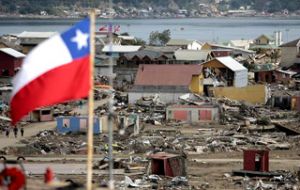MercoPress. South Atlantic News Agency
Most Chilean fatalities may have resulted from tsunami, say officials
 Coastal areas suffered the most from the earthquake impact
Coastal areas suffered the most from the earthquake impact Chilean disaster officials are now saying the majority of the country’s fatalities may have resulted from the earthquake-generated waves that struck coastal towns like Constitución, where 350 people were killed.
Minutes after Saturday's quake, Chilean officials told coastal communities like Constitución that there was little danger of a tsunami. But a 7.5-ft wave later struck the village of Talcahuano, less than 20 minutes after the first quake.
Jane Lubchenco, head of the National Oceanic and Atmospheric Administration in Washington, said because the communities were so close to the epicentre, Saturday’s tsunami waves arrived “almost instantaneously”, Lubchenco said it would have been virtually impossible to move quickly enough to get out of harm's way when the quake hit. “They didn't have the benefit of early warning in this case,” she said.
A US geologist said it was difficult to understand how Chile’s leaders did not foresee a major tsunami, at least for its own coast so close to the epicentre.
“Not only was this one of the most powerful earthquakes we've seen in years, its movement was mostly vertical, which produces the most dangerous tsunamis,” he said.
Just hours after the quake, President Michelle Bachelet relayed information downplaying tsunamis fears – based on an evaluation given her by the Navy office in charge of monitoring events of this kind.
Fears of another tsunami sparked a false panic after an aftershock measuring 5.9 on the Richter scale hit southern Chile’s Region VIII on Wednesday.
Nearly half an hour after the aftershock hit, just before 3 p.m., fire fighters in the area issued tsunami warnings, ordering citizens to evacuate the city. Around 20 minutes later, Onemi, Chile’s national office of Emergency, said there was a tsunami alert in the area.
Residents of Region VIII and coastal towns fled to neighbouring hills, while a traffic jam leading to the Llacolen Bridge stretched for nearly 20 blocks. But at 3:27pm the Navy sent out faxes dismissing threats of a tsunami. Police informed citizens that it was a false alarm and they could return to their homes.
Area residents now accuse fire fighters of causing false panic. Interior Minister Edmundo Perez Yoma said people are already nervous and information like this only causes situations of uncontrollable panic. “Fire-fighters should not have done that,” he said.
Concepcion fire superintendent Luis Vasquez said his organization had been given information from their central provincial office and - as fire-fighters belonging to the province - they could not ignore the fatalities.
By Laura Burgoine - Santiago Times




Top Comments
Disclaimer & comment rulesCommenting for this story is now closed.
If you have a Facebook account, become a fan and comment on our Facebook Page!